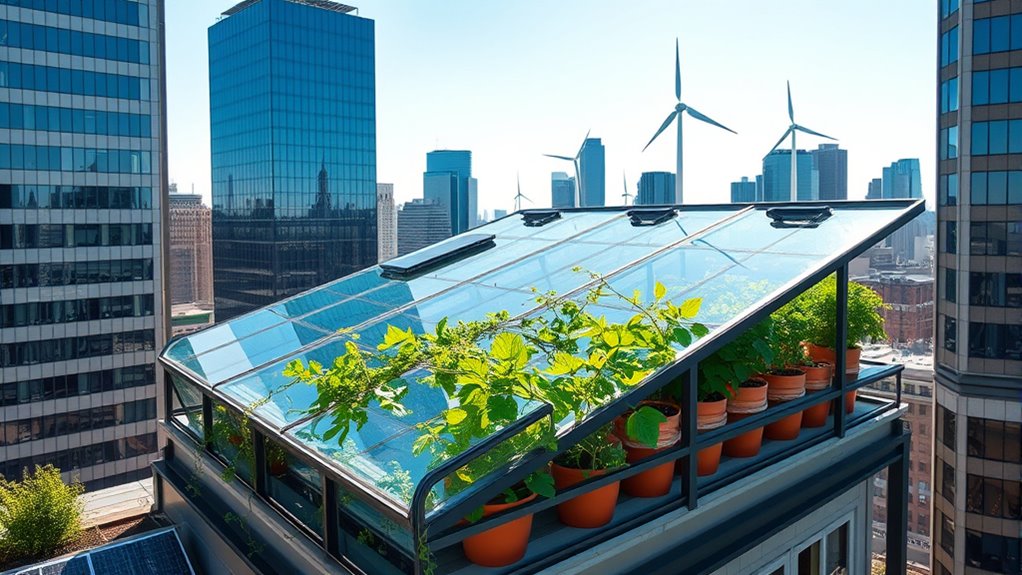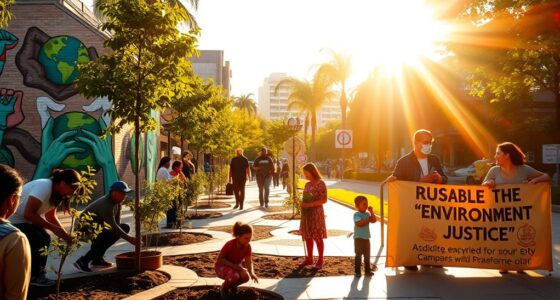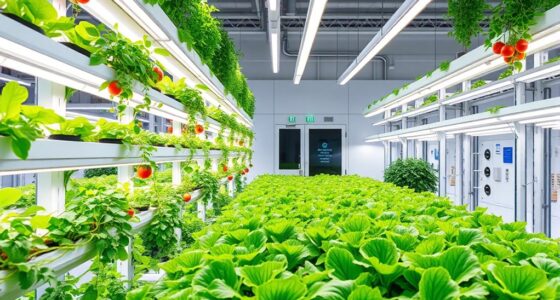Traversing rooftop greenhouse zoning can be tricky because many laws are behind-the-scenes but vital for your urban farm. Building codes cover safety standards and structural integrity, while zoning rules often regulate height, sunlight access, and design aesthetics. Understanding these local regulations helps you stay compliant, avoid delays, and take advantage of grants or incentives. Knowing how laws work in your area guarantees your rooftop farm is both innovative and legal—keep going to discover more tips for success.
Key Takeaways
- Zoning laws often regulate rooftop greenhouse height, placement, and sunlight access to prevent shading of neighboring properties.
- Building codes specify safety standards, structural integrity, and fire safety measures for rooftop greenhouses.
- Permits and variances may be required for innovative designs or materials to comply with aesthetic and safety regulations.
- Urban farming incentives and grants depend on adherence to local zoning and building codes.
- Engaging with city officials and researching local laws ensures legal compliance and facilitates project approval.

Have you ever considered how zoning regulations can shape the future of rooftop greenhouses? These regulations aren’t just bureaucratic hurdles; they define where and how you can build innovative urban farms. When planning a rooftop greenhouse, understanding local building codes is essential. Building codes set the safety standards for structures, including height restrictions, fire safety measures, and structural integrity. They ensure your greenhouse can withstand weather conditions and won’t compromise the building’s stability. Ignoring these codes can lead to costly delays or even legal issues, so it’s crucial to familiarize yourself with them early in the planning process.
Understanding local building codes is essential for safe, compliant rooftop greenhouse projects.
Sunlight access is another critical factor that zoning laws often regulate, especially for rooftop greenhouses. These laws can limit the height or placement of structures to prevent obstruction of sunlight to neighboring buildings or public spaces. Sunlight is vital for plant growth, so restrictions that limit shading or require specific setbacks ensure your greenhouse receives enough natural light. You might need to conduct sunlight studies or work with city planners to demonstrate that your project won’t negatively impact surrounding properties. Failing to secure adequate sunlight access can compromise your crop yields and sustainability goals, which defeats the purpose of urban farming.
Zoning regulations can also influence the design and aesthetic aspects of rooftop greenhouses. Cities often have aesthetic guidelines aimed at preserving the skyline or maintaining neighborhood character. These rules might restrict certain materials, colors, or structural styles. If you’re aiming for a sleek, modern greenhouse, you’ll need to verify that your design aligns with these aesthetic standards. Sometimes, zoning laws require special permits or variances for innovative or unconventional structures, so proactive communication with city authorities can smooth the approval process.
Furthermore, zoning can determine whether your rooftop greenhouse qualifies for incentives or grants. Many cities encourage urban agriculture by offering zoning flexibility or financial support for green initiatives, but eligibility often hinges on compliance with specific building codes and zoning regulations. Understanding these rules helps you leverage available resources and avoid surprises during application processes.
In addition, fostering a strong understanding of creative practice can help in designing innovative solutions that meet zoning standards while maximizing your rooftop space. In essence, zoning regulations are the backbone of successful rooftop greenhouse projects. They impact everything from safety and sunlight access to design and incentives. By proactively navigating building codes and sunlight regulations, you empower yourself to turn an urban rooftop into a thriving farm space. Keep in mind that these laws vary widely by location, so local research and engaging with city officials are your best strategies for turning your rooftop farming dreams into reality.
Frequently Asked Questions
How Do Zoning Laws Differ Between Cities for Rooftop Greenhouses?
You’ll find zoning laws for rooftop greenhouses differ widely between cities. Some cities have strict building codes that regulate size, height, and safety features, while others are more flexible. If you’re in a historic district, additional restrictions may apply to preserve aesthetic integrity, limiting rooftop greenhouse options. It’s essential to verify local zoning laws, building codes, and historic district regulations to ensure your rooftop greenhouse complies with all requirements.
What Permits Are Required to Build a Rooftop Greenhouse Legally?
Oh, the joy of building a rooftop greenhouse—just a few permits, right? You’ll need to check local building codes to guarantee safety and compliance. Don’t forget environmental impact assessments if required, especially in eco-conscious areas. Usually, you’ll need a building permit, possibly a zoning variance, and sometimes an environmental review. It’s a hassle, but it’s all about keeping your urban farm safe, legal, and eco-friendly.
Are There Specific Height Restrictions for Rooftop Greenhouses?
You might wonder if there are height restrictions for rooftop greenhouses. Building codes focus on structural safety, so they set height limits to ensure stability and safety. These restrictions vary depending on your location and building type. To stay compliant, check local zoning laws and building regulations. Always consult with authorities or a professional to ensure your rooftop greenhouse adheres to height limits and safety standards.
How Do Zoning Laws Impact the Types of Crops That Can Be Grown?
Imagine you’re in the days of the Renaissance, where rules shaped what you could grow. Zoning laws directly impact your crop choices by enforcing soil restrictions and water usage limits. These laws determine which crops are feasible, especially in rooftop greenhouses, affecting your farming options. You must navigate these regulations carefully to guarantee your urban farm thrives without violating local ordinances or risking penalties.
Can Rooftop Greenhouses Be Used for Commercial Farming Within Zoning Laws?
You can use rooftop greenhouses for commercial urban agriculture if zoning laws allow it. Many areas support rooftop design that encourages urban farming, but regulations vary. Check local zoning codes to make sure your rooftop greenhouse complies with restrictions on commercial activities. When permitted, rooftop greenhouses are excellent for growing crops efficiently in urban settings, promoting sustainable food production and maximizing limited space for urban agriculture.
Conclusion
As you stand on a rooftop greenhouse, it’s easy to feel like you’re part of something bigger—an urban revolution powered by overlooked laws. These zoning rules quietly shape your city’s green future, making your efforts possible. Sometimes, it’s the hidden details that turn dreams into reality. So, next time you tend your plants, remember: beneath the surface, unseen laws are quietly working to nurture your green sanctuary.









